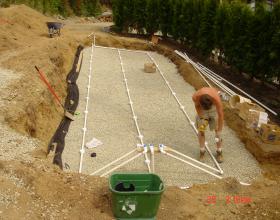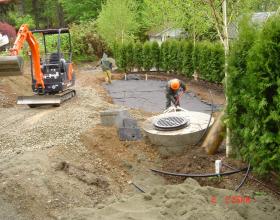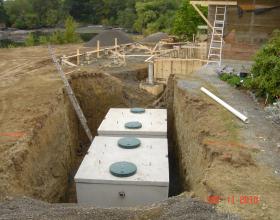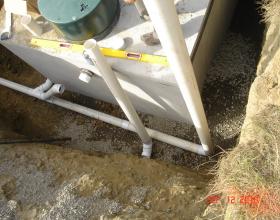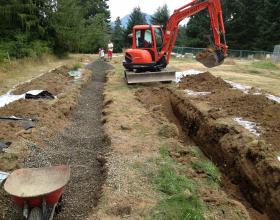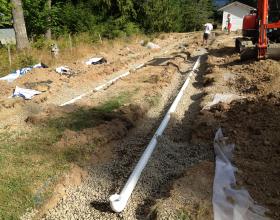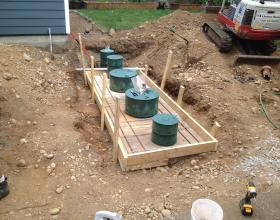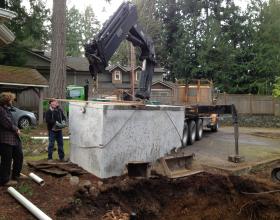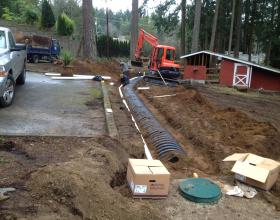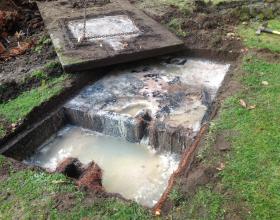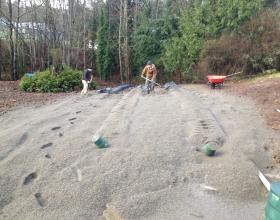Pacific Group Developments is a full service septic system company. We have been serving Victoria and outlying areas for over 25 years, installing septic tanks, septic treatment plants, septic drain fields and providing services such as septic inspections and septic system maintenance. We are knowledgeable in septic systems and are eager to assist you in your questions, maintenance, inspection and construction needs.
About Septic Systems
A septic system is used to treat sewage and wastewater by allowing the solids to decompose and settle in a tank then letting the liquids to be absorbed by the soil in drainage field.
The best method of handling residential sewage is through a properly designed and operated community or municipal sewage treatment system. But many areas of British Columbia have populations so low that installation costs prohibit using community systems. In these areas we must rely on individual onsite septic systems for sewage disposal.
Septic systems have improved in recent years and are a great way to treat sewage, provided they’re properly maintained. A septic system needs to meet your specific needs for current and future demands with the health of your family and environmental impact as a main focus. Septic fields can be hazardous to the environment, your family, pets, and costly to repair if not properly taken care of and inspected annually.
Types of Septic Systems
There are two generally recognized methods of handling septic waste. They are conventional septic systems and alternative septic systems.
Alternative septic systems are used in cases where conventional septic systems cannot be used due to sensitive environmental areas, low topsoil depth, or the soil is not suited to conventional septic systems or small lots.
Conventional Septic Systems
Gravity septic systems - are the most basic systems and use the force of gravity for drainage. The effluent is pulled from the building into the septic tank and from the septic tank into the septic drainage field where it is naturally filtered and further treated before returning to the environment.
Pressure distribution systems - are the most common septic systems because of it's ability to use the drainage field at optimum efficiency The Pressure distribution system can be used in places that gravity septic systems can not be used due to topography.
This system needs an electric pump in a pump tank / pump chamber to pressurize the field.
Alternative Septic Systems
Aerobic treatment systems - Uses oxygen to promote biological bacteria growth to accelerate decomposition. An acceleration chamber uses forced air to mix the wastewater, accelerating bacteria growth, which results in a cleaner septic system.
Mound septic systems - Are used when there is not enough soil depth for a traditional septic system. A mound septic system is above ground level.
Before installing a septic system a design is required to be submitted to the ministry of health to obtain a permit to construct or alter a septic system.
Design a Septic System
- Soil conditions must be first analyzed. This will be done by perc tests and inspection holes to establish native soil depths, water table, saturated soil, slope, soil type, and rates of absorption.
- The type of use we are servicing must be established. It could be industrial, commercial, or residential. The number of bedrooms, bathrooms, square footage and number of people all need to be calculated.
- When choosing a septic location, considerations are also made for distances to wells, property lines, watercourses, wetlands, driveways, buildings, rock and topography is also considered.
- Once this data in calculated the appropriate type and size of sewage disposal system and location can be determined to maximize the longevity and integrity of your new system.
Pacific Group Developments technical staff will help you determine and design the type of septic system for you.
In many cases thoughts of renovating a home with an existing septic system or an application for a building permit will trigger a process to assess your current sewage waste management system and review you increased needs. In most cases the septic tank and septic drain field may be smaller than required because provincial regulations have become more stringent with efforts to protect the environment. In this case an upgrade is required. In some cases you can add to your septic drain field or add an additional tank. In others a new system may be required.
Septic Systems / Subdivisions
Subdivisions of land in and rural areas without municipal or community sewer service, the minimum lot size must be larger to accommodate a septic system. Anyone wanting to subdivide their land must prove the land’s ability to provide safe onsite sewage disposal and in some cases must prove not only a septic drain field area but also a reserve septic drain field area. This reserve septic drain field area is to provide onsite sewage disposal in the future after the primary drain field fails, or for expansion.
We offer site evaluations, for septic system design, septic system installation, septic system maintenance, inspection and feasibility studies for subdivision of property.

